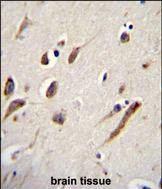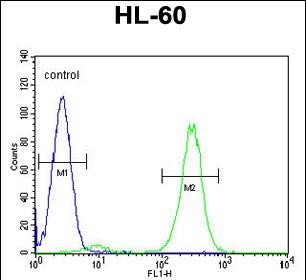FBXW11 Antibody (Center)
Affinity Purified Rabbit Polyclonal Antibody (Pab)
- SPECIFICATION
- CITATIONS: 1
- PROTOCOLS
- BACKGROUND

Application
| FC, WB, IHC-P, E |
|---|---|
| Primary Accession | Q9UKB1 |
| Other Accession | Q5SRY7, NP_036432 |
| Reactivity | Human |
| Predicted | Mouse |
| Host | Rabbit |
| Clonality | Polyclonal |
| Isotype | Rabbit IgG |
| Calculated MW | 62091 Da |
| Antigen Region | 168-196 aa |
| Gene ID | 23291 |
|---|---|
| Other Names | F-box/WD repeat-containing protein 11, F-box and WD repeats protein beta-TrCP2, F-box/WD repeat-containing protein 1B, Homologous to Slimb protein, HOS, FBXW11, BTRCP2, FBW1B, FBXW1B, KIAA0696 |
| Target/Specificity | This FBXW11 antibody is generated from rabbits immunized with a KLH conjugated synthetic peptide between 168-196 amino acids from the Central region of human FBXW11. |
| Dilution | WB~~1:1000 IHC-P~~1:50~100 FC~~1:10~50 |
| Format | Purified polyclonal antibody supplied in PBS with 0.09% (W/V) sodium azide. This antibody is purified through a protein A column, followed by peptide affinity purification. |
| Storage | Maintain refrigerated at 2-8°C for up to 2 weeks. For long term storage store at -20°C in small aliquots to prevent freeze-thaw cycles. |
| Precautions | FBXW11 Antibody (Center) is for research use only and not for use in diagnostic or therapeutic procedures. |
| Name | FBXW11 {ECO:0000303|PubMed:26837067, ECO:0000312|HGNC:HGNC:13607} |
|---|---|
| Function | Substrate recognition component of a SCF (SKP1-CUL1-F-box protein) E3 ubiquitin-protein ligase complex which mediates the ubiquitination and subsequent proteasomal degradation of target proteins (PubMed:10437795, PubMed:11158290, PubMed:10648623, PubMed:20347421, PubMed:19966869, PubMed:22017875, PubMed:22017876, PubMed:36608670). Probably recognizes and binds to phosphorylated target proteins: the interaction with substrates requires the phosphorylation of the two serine residues in the substrates' destruction motif D-S-G-X(2,3,4)-S (PubMed:10437795, PubMed:10648623, PubMed:20347421, PubMed:19966869, PubMed:22017875, PubMed:22017876, PubMed:36608670). SCF(FBXW11) mediates the ubiquitination of phosphorylated CTNNB1 and participates in Wnt signaling regulation (PubMed:10321728). SCF(FBXW11) plays a key role in NF-kappa-B activation by mediating ubiquitination of phosphorylated NFKBIA, leading to its degradation by the proteasome, thereby allowing the associated NF-kappa-B complex to translocate into the nucleus and to activate transcription (PubMed:10321728, PubMed:10644755, PubMed:10437795, PubMed:20347421). The SCF(FBXW11) complex also regulates NF-kappa-B by mediating ubiquitination of phosphorylated NFKB1: specifically ubiquitinates the p105 form of NFKB1, leading to its degradation (PubMed:11158290). SCF(FBXW11) mediates the ubiquitination of IFNAR1 (PubMed:14532120, PubMed:15337770). SCF(FBXW11) mediates the ubiquitination of CEP68; this is required for centriole separation during mitosis (PubMed:25503564). Involved in the oxidative stress-induced a ubiquitin-mediated decrease in RCAN1 (PubMed:18575781). Mediates the degradation of CDC25A induced by ionizing radiation in cells progressing through S phase and thus may function in the intra-S-phase checkpoint (PubMed:14603323). Has an essential role in the control of the clock-dependent transcription via degradation of phosphorylated PER1 and phosphorylated PER2 (PubMed:15917222). SCF(FBXW11) mediates the ubiquitination of CYTH1, and probably CYTH2 (PubMed:29420262). SCF(FBXW11) acts as a regulator of mTORC1 signaling pathway by catalyzing ubiquitination and subsequent proteasomal degradation of phosphorylated DEPTOR, TFE3 and MITF (PubMed:22017875, PubMed:22017876, PubMed:36608670). |
| Cellular Location | Cytoplasm {ECO:0000250|UniProtKB:Q5SRY7}. Nucleus {ECO:0000250|UniProtKB:Q5SRY7} |

Provided below are standard protocols that you may find useful for product applications.
Background
This gene encodes a member of the F-box protein family which is characterized by an approximately 40 amino acid motif, the F-box. The F-box proteins constitute one of the four subunits of ubiquitin protein ligase complex called SCFs (SKP1-cullin-F-box), which function in phosphorylation-dependent ubiquitination. The F-box proteins are divided into 3 classes: Fbws containing WD-40 domains, Fbls containing leucine-rich repeats, and Fbxs containing either different protein-protein interaction modules or no recognizable motifs. The protein encoded by this gene belongs to the Fbws class and, in addition to an F-box, contains multiple WD40 repeats. This gene contains at least 14 exons, and its alternative splicing generates 3 transcript variants diverging at the presence/absence of two alternate exons.
References
Peschiaroli, A., et al. Oncogene 29(9):1384-1393(2010)
Lievens, S., et al. J. Proteome Res. 8(2):877-886(2009)
Ewing, R.M., et al. Mol. Syst. Biol. 3, 89 (2007) :
Peschiaroli, A., et al. Mol. Cell 23(3):319-329(2006)
Sabile, A., et al. Mol. Cell. Biol. 26(16):5994-6004(2006)
If you have used an Abcepta product and would like to share how it has performed, please click on the "Submit Review" button and provide the requested information. Our staff will examine and post your review and contact you if needed.
If you have any additional inquiries please email technical services at tech@abcepta.com.















 Foundational characteristics of cancer include proliferation, angiogenesis, migration, evasion of apoptosis, and cellular immortality. Find key markers for these cellular processes and antibodies to detect them.
Foundational characteristics of cancer include proliferation, angiogenesis, migration, evasion of apoptosis, and cellular immortality. Find key markers for these cellular processes and antibodies to detect them. The SUMOplot™ Analysis Program predicts and scores sumoylation sites in your protein. SUMOylation is a post-translational modification involved in various cellular processes, such as nuclear-cytosolic transport, transcriptional regulation, apoptosis, protein stability, response to stress, and progression through the cell cycle.
The SUMOplot™ Analysis Program predicts and scores sumoylation sites in your protein. SUMOylation is a post-translational modification involved in various cellular processes, such as nuclear-cytosolic transport, transcriptional regulation, apoptosis, protein stability, response to stress, and progression through the cell cycle. The Autophagy Receptor Motif Plotter predicts and scores autophagy receptor binding sites in your protein. Identifying proteins connected to this pathway is critical to understanding the role of autophagy in physiological as well as pathological processes such as development, differentiation, neurodegenerative diseases, stress, infection, and cancer.
The Autophagy Receptor Motif Plotter predicts and scores autophagy receptor binding sites in your protein. Identifying proteins connected to this pathway is critical to understanding the role of autophagy in physiological as well as pathological processes such as development, differentiation, neurodegenerative diseases, stress, infection, and cancer.



